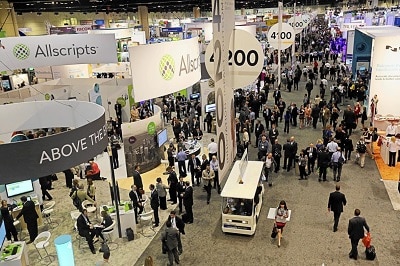For anyone who has attended the annual HIMSS conference, you know it can be overwhelming. 2017’s HIMSS Annual Conference was no different, with over 40,000 health IT professionals and 1,200+ exhibitors sprawled across what seemed like miles of exhibit hall space at the Orange County Convention Center in Orlando. It was abundantly clear that this year, the healthcare industry is hungry for technology solutions to drive efficiency and improve patient experiences.
Much of the buzz at the event was centered on a handful of core topics, so we wanted to share some of those key takeaways here for those of you who weren’t able to make it out to Orlando this year.
1) Everyone wants the cloud, but they have security concerns around the cloud.
Across all the conversations I had at HIMSS, administrators and IT directors were very interested in capitalizing on the reliability, scalability, flexibility and operational efficiencies of moving their IT to the cloud, but at the same time offered hesitations around compliance and security issues of doing so. There continues to be a bombardment of cyber-attacks in the healthcare space, which makes providers nervous about relying on the hyperscale cloud (like Azure, AWS or Google) to protect their patients’ data. What’s important to note here, and something that we’re passionate about educating on here at Netgain, is that companies like Microsoft, Amazon and Google pour billions of dollars into ensuring that security and compliance measures are met. Can you say the same about your organization’s in-house investments in IT security? What’s more, if you can get indemnification assurances from your vendor(s) in the business associates agreement (BAA), it greatly minimizes your risk and liability in moving your IT to the cloud.
2) Interoperability is tough…
Interoperability, or how well your IT apps communicate with each other (and how well your apps communicate with the apps of another organization), is a newer industry challenge that has developed as more healthcare organizations adopt new technologies and vendors. The challenge is that without standard protocols and technologies to ensure functionality and communication between apps, interoperability remains a long shot. Wouldn’t it be great if your EHR system would seamlessly communicate and integrate with your lab, pharmacy and practice management apps? Your patients want this too, which is why a lot of organizations and vendors are trying to solve the interoperability riddle this year.
3) …and integration solutions are the answer.
There are some promising integration companies that we saw at HIMSS that are working diligently (and some are succeeding) to deliver a semblance of interoperability through their solutions. No one is running away with the solution to interoperability yet, but there are several companies in this space that we’re keeping our eye on. More to come on that in the near future.
4) The Health IT innovation scene is burgeoning.
You could be forgiven if you missed the corner of the exhibit hall that housed the booths for the companies that didn’t have $100K+ to spend on multi-story tradeshow booths. These innovation-focused vendors were tucked away at HIMSS, but should not have been missed. Health IT has long suffered from a lack of motivation to innovate. Organizations are hesitant to switch from the slower-to-innovate legacy vendors that have dominated the space for many years for what seems to be fear of potentially fatal incidences, but the reality is that there are hundreds of companies that are innovating to solve today’s health IT challenges that will fundamentally shift the entire patient-provider-payer relationship within the next 18 months, and those organizations that are resistant to embrace (or at least consider) more innovative solutions are going to get left behind.
5) Artificial intelligence is real.
Pardon the play on words, but artificial intelligence (AI) is building up a lot of steam with the healthcare vertical locked squarely in its sights. Thanks to IBM Watson and other machine learning technologies, vendors are capitalizing on the big data and machine learning renaissance to revolutionize how patient care is delivered. Machine learning is being used to drive diagnoses, research and create evidence-based treatment plans and guide personalized follow-up care. Machine learning is still finding its place in healthcare, but it’s simply a matter of time before AI becomes commonplace in the industry.
There are some incredible developments in the health IT space that are worth monitoring over the coming months and years, and HIMSS provided a glimpse (albeit a massive one) into what’s on the horizon in health IT. Were you at HIMSS or have you been following some of the developments in the health IT space? What are you most excited/anxious/fearful/optimistic about?
